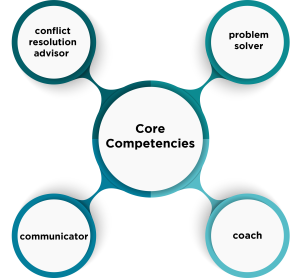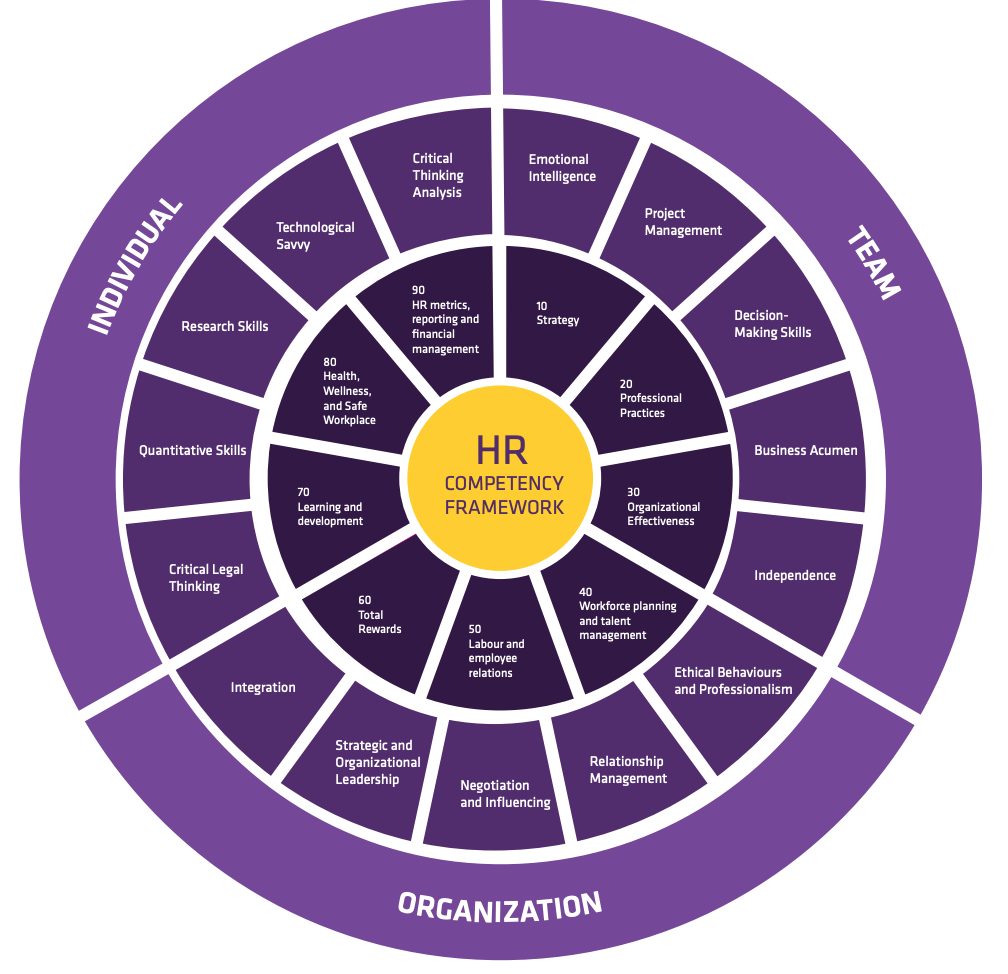1.2 Human Resources Core Competencies

Human Resources professionals rely on core competencies such as leadership skills, legislative compliance, analytical skills and strategic planning to perform their jobs. There are additional competencies that lend themselves well to problem-solving and conflict resolution.
Let us look closer at four core competencies that Human Resources professionals rely on to solve problems and address workplace conflicts.
The Problem Solver
You are known for brainstorming solutions and addressing concerns and challenges in a timely manner.
Scenario: Your day shift Supervisor asks you to hire two additional Production Associates for the day shift as they are experiencing staffing issues. You run an absence report and discover that there is an attendance issue on the day shift.
Solution: Rather than hire two more employees, you set up employee meetings to address the attendance issues and issue Performance Improvement Plans (PIP) to the impacted employees.
The Conflict Resolution Advisor
You can identify disagreements between individuals and act as an advisor.
Scenario: Your Quality Manager asks you to prepare a termination letter for one of their QA Technicians. You are shocked as this employee has never had performance issues. Your quality manager explains that their QA Technician continues to disagree with every decision they make and is tired of dealing with this individual.
Solution: Rather than preparing a termination letter, you encourage your Quality Manager to sit down with their QA Technician to determine what is behind this recent change in performance. You provide the Quality Manager with questions that will help with the discussion and suggestions based on what they uncover during their conversation.
The Coach
You provide people leaders with useful tips and approaches to address workplace conflict.
Scenario: Your Operations Manager shares that they are hosting an upcoming training session for their Supervisors. One topic on their agenda is the importance of addressing workplace conflict promptly.
Solution: You sit down with your operations manager and provide them with exercises their supervisors could work through during the upcoming training session.
The Communicator
You can communicate with others using verbal and non-verbal communication.
Scenario: Your Office Manager is upset. They are tired of their Administrative Assistant standing in front of them with their arms crossed in front of their chest every time they ask for help with upcoming orientation sessions. They can tell the Administrative Assistant doesn’t want anything to do with the orientation sessions based on their defensive body language.
Solution: You meet with your Office Manager and discuss non-verbal communication. You share that while the Administrative Assistant may be uninterested in helping with the orientation sessions, it is also possible they prefer to stand with their arms crossed in front of them as a matter of comfort.
HRPA Competency Framework

Image Description
A circular HR Competency Framework diagram is divided into three primary sections: Individual, Team, and Organization.
Individual Competencies (left side of the outer circle): Technological Savvy, Research Skills, Quantitative Skills, Critical Legal Thinking, Critical Thinking Analysis.
Team Competencies (right side of the outer circle): Emotional Intelligence, Project Management, Decision-Making Skills, Business Acumen, Independence.
Organizational Competencies (bottom of the outer circle): Integration, Strategic and Organizational Leadership, Negotiation and Influencing, Relationship Management, Ethical Behaviors and Professionalism.
The inner circle contains core HR functional areas represented by numerical categories:
10: Strategy
20: Professional Practices
30: Organizational Effectiveness
40: Workforce Planning and Talent Management
50: Labour and Employee Relations
60: Total Rewards
70: Learning and Development
80: Health, Wellness, and Safe Workplace
90: HR Metrics, Reporting, and Financial Management
At the center of the diagram is a yellow circle labelled “HR Competency Framework.”
Professional Practice for HR Professionals
Human Resources Professional’s mandate is to manage the “human resources” of an organization. Their role is to balance the needs of the organization, its people, and society. They have a significant influence on the culture of the organization in creating an efficient workplace. They need to create working relationships that enhance teamwork. Much of the work of HR Professionals follows the four Ps: policy, practice, procedure, and programs. Strategically, HR Professionals must consider the topics listed in the table below. The table highlights the HRPA competencies and topics covered in this textbook.
|
HRPA Competency |
HR Topics |
| 10 Strategy | Think and act strategically |
| Design a strategy that is diverse, inclusive and equitable for all employees | |
| Adhere to all federal, provincial and territory laws | |
| 20 Professional Practice | Conduct oneself in a professional manner |
| 30 Organizational Effectiveness | Maximize performance of individuals, teams and organization |
| 70 Learning and Development | Develop competencies, skills and talents of individuals, teams and organizations as a whole |
| 80 Health, Wellness and Safe Workplace | Create and maintain a healthy and safe work environment |
“HRPA Competency Framework” from Human Resources Management by Debra Patterson is licensed under a Creative Commons Attribution-NonCommercial-ShareAlike 4.0 International License, except where otherwise noted. Modifications: only included the competencies as they relate to this book.

